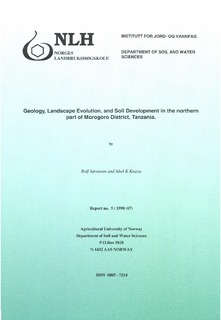| dc.contributor.author | Sørensen, Rolf | |
| dc.contributor.author | Kaaya, Abel K. | |
| dc.date.accessioned | 2019-02-26T11:50:30Z | |
| dc.date.available | 2019-02-26T11:50:30Z | |
| dc.date.issued | 1998-08 | |
| dc.identifier.issn | 0805-7214 | |
| dc.identifier.uri | http://hdl.handle.net/11250/2587444 | |
| dc.description | Fra Institutt for jord- og vannfag. Rapport nr. 5/1998 (67). Faggruppe: Jordfag. Geografisk område: Tanzania. | nb_NO |
| dc.description.abstract | The area between the Uluguru and Kaguru - Rubeho mountains in the northern part of Morogoro District, Tanzania, has been investigated. Two different groups of bedrock, the granulites and biotite-hornblende gneisses, and the migmatites and miscovite-biotite gneisses have been considered as the most important parent materials for saprolite and soils. Saprolite thickness range from almost zero to > 50 meters, depending on rock properties. Landscape development in the area, and palaeoecological development of East Africa have been reviewed from recent literature, and adapted for the study area. Climatic cycles of approximatly 141 and 100 kyr duration, with cool/dry and warm/ humid phases have influenced vegetation cover, geological processes and soil development in the study area. Late Holocene sediment accumulation rates on the Mkata and Ngerengere River floodplains have been calculated to 0.7 and 2 mm yr-1 respectivly. Earlier studies on local erosion report rates of defnudation in central Tanzania that range from 30 - 60 mm kyr-1. Saproite formation and denudation are assumed to have been in near balance during the Guaternary period. Several forms of pedogenic calcrete occur on the moderate to lower slopes, over different bedrocks. Calcite or low Mg-calcite dominate in the calcretes and stable oxygen isotope analysis indicate their formation in a cooler climate. The carbonate concretions formed 26 - 30 kyr BP, and more mature calcretes have probably formed furing the Quaternary 'glacial' episodes- Clavey colluvium on the northern footslopes of the Uluguru Mts. have mainly been formed by landslides and mudflows during the termination of the 'glacials'. The sandy colluvium along Mindu Mts. have formed by slope wash during the last 100 kyr. Two toposequences are described with respect to parent material formation, slope processes and soil deelopment. The latter has been strongest during interglacials, but indication of weak soil development 30 to 40 kyr ago has been observed. Some further investigations are suggested. | nb_NO |
| dc.language.iso | eng | nb_NO |
| dc.publisher | Institutt for jord- og vannfag | nb_NO |
| dc.rights | Attribution-NonCommercial-NoDerivatives 4.0 Internasjonal | * |
| dc.rights.uri | http://creativecommons.org/licenses/by-nc-nd/4.0/deed.no | * |
| dc.subject | Soil mineralogy | nb_NO |
| dc.subject | Soil profiles | nb_NO |
| dc.subject | Uluguru mountains, Tanzania | nb_NO |
| dc.subject | Weathering | nb_NO |
| dc.title | Geology, Landscape Evolution and Soil Development in the northern part of Morogoro District, Tanzania | nb_NO |
| dc.type | Research report | nb_NO |
| dc.source.pagenumber | 38 | nb_NO |
| cristin.fulltext | | |
| cristin.fulltext | dc. dscription | |
| cristin.fulltext | dc.description | nb_NO |

